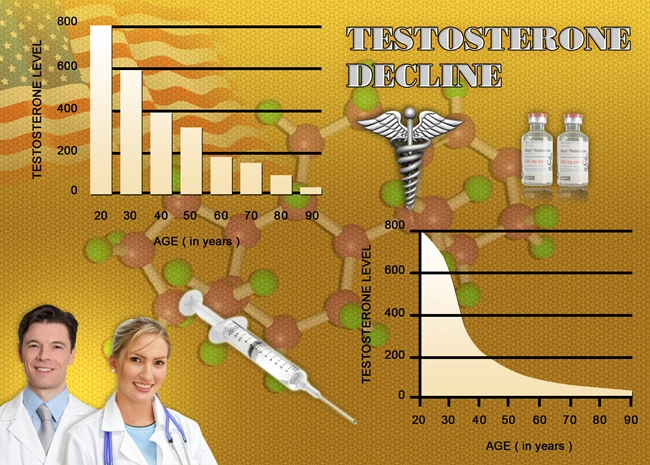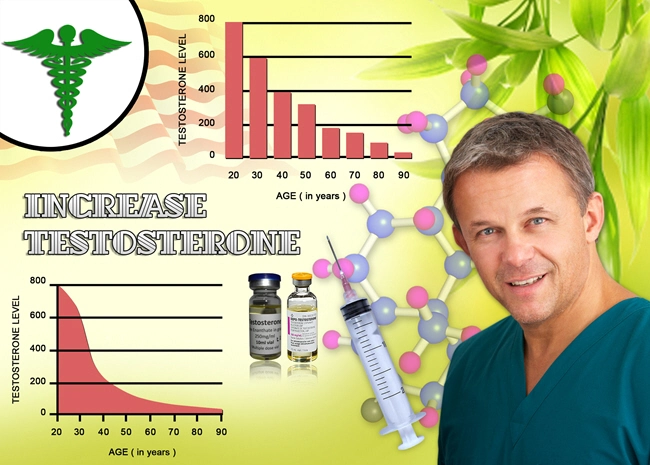
Systems to Monitor Testosterone Replacement Therapy (TRT)
A grim reality of aging is the decline of our hormones. Beginning at approximately age 30, we begin to lose most hormones at a rate of around 10% per decade, which eventually results in a condition called late-onset hypogonadism (LOH). The drop in testosterone levels (aka “Low-T”) can be particularly debilitating for men. Here are a few of the consequences of testosterone loss:
- Chronic fatigue
- Loss of strength and muscle mass
- Insomnia and an inability to stay asleep
- Increased joint aches and pains
- Depression
- Mental fog and an impaired memory
- Dried, wrinkled skin
- Erectile dysfunction
- Loss of libido
- Lower urinary tract issues
- And more. All of these symptoms result in a reduced, depleted quality of life (QoL).
Testosterone Replacement Therapy to the Rescue
Testosterone Replacement Therapy (TRT) has been proven to ease – and at times reverse – the procession of the destroyers mentioned above of men’s quality of life. This conclusion about TRT’s benefits is based on the anecdotal testimonials of TRT patients and several medical metrics.
However, to date, there has no one absolute, fool-proof tool to access the quality of life for men undergoing testosterone replacement therapy.
A recent study examined the various ways available to quantify TRT’s benefits.
Low-T causes are numerous, but the research broke them down into two main groups: primary hypogonadism caused by testicular failure or acquired or congenital secondary hypogonadism, which traces the origin of these conditions to the hypothalamus or the pituitary gland.
Hypogonadism is a clinical condition. Questionnaires and scoring systems represent the standard tools to measure the effectiveness of testosterone treatment . While these tools have been somewhat effective, researchers have concluded that a more precise, comprehensive tool is needed when men suffer from erectile dysfunction, depression, or chronic pain.
. While these tools have been somewhat effective, researchers have concluded that a more precise, comprehensive tool is needed when men suffer from erectile dysfunction, depression, or chronic pain.
The study reviewed the available tools that monitor QoL in adult men with LOH taking TRT and provided evidence for the effectiveness and limitations of the tools. Here is a look at the various tools:
- The Aging Males’ Symptoms (AMS) scale has been used since 1999 and evaluates the symptoms and severity of Low-T and the patient's response to testosterone treatment. The scale consists of 17 questions concerning symptoms and varies from 17 (minimal significance) to 85 (severe symptoms of Low-T). The questions also ask about insomnia, a common occurrence for hypogonadal men. The tool is quite common and tracks the severity of symptoms and complexity of Low-T.
- The androgen deficiency in the aging male (ADAM) questionnaire is another questionnaire used to discover Low-T and its symptoms. This approach asks 10 questions concerning libido, fatigue, mood, chronic pain, and daily activities. ADAM is not used as often as AMS.
- The Short-form health survey (SF) focuses on the QoL in patients with chronic conditions, social activities, pain, energy, general health, mental health, and emotions. Initially, the short form survey contained 36 questions, but a shorter version has also been used.
- The international prostate symptoms score (IPSS) is designed to monitor the effect of TRT on prostate growth. Some increase in prostate size but no urinary difficulties has been reported in some men undergoing TRT. The link between TRT and prostate problems is not definitive since many of the men on TRT are older and suffer from lower urinary tract symptoms (LUTS) more often than younger men. The score is an early-warning system that may occur during TRT and require immediate treatment.
- The International Index of Erectile Function (IIEF) evaluates the severity of Erectile Dysfunction (ED) in men taking testosterone therapy. ED is a frequent symptom of Low-T, and this tool is geared toward assessing sexual vitality and mood. The questionnaire is extensive, consisting of 90 questions.
- The Derogatis interview for sexual functioning (DISF-SRII), The daily psychosexual questionnaire (PDQ), and The Male Sexual function inventory (BMSFI) are all similar questionnaires that focus on male sexual health.
- Mood swings and depression are other hallmarks of Low-T. As mentioned earlier, the Short-form health survey (SF) is a tried-and-true approach to tracking the mental health of TRT patients. The symptom checklist 90 revised (SCL-90-R) consists of 90 questions and emphasizes the psychological health of mentally ill patients or those in traumatic situations. The questionnaire asks questions about anger and guilt and is used to determine psychological issues in men with Klinefelter syndrome.
- The Domains of the AMS questionnaire is administered periodically throughout the TRT regimen. The Hamilton depression rating scale (HAM-D) and the Endicott quality of life enjoyment and satisfaction scale (Q-LES-Q) are used at diagnosis, follow-up, and to watch for relapse.
These psychological assessments are crucial for men during testosterone treatment since most men experiencing the acute adverse effects of Low-T are at high risk of depression, regardless of their age or the cause of their loss of testosterone.
The advantage of these questionnaires is that they are affordable, quick, and easy to conduct and may lead to further understanding and research. The downside is that they may be subject to reporting and confirmation bias and are subjective.
Another downside of these assessment tools is that no one tool covers all bases. The AMS scale and the short-form health survey cover most mental health and well-being areas, but they are not as focused on depression as the extent of the HAM-D scale. But the HAM-D scale does not cover the broad range of questions  like the AMS and short-form surveys.
like the AMS and short-form surveys.
Another area of concern is the possible link between prostate cancer and TRT. The connection has been debunked, but it still remains an area of concern. The key is to measure biochemical markers (e.g., hematocrit, serum testosterone, lipid markers, etc.) throughout the ongoing TRT and treat any adverse developments.
To conclude, the researchers acknowledge the limitations of their study. The determination of the scoring systems was discretionary and based on the researcher’s judgment. The study’s goal was to review the use of these surveys and not perform a qualitative, quantitative, or comprehensive analysis.
The takeaway is this: there is no one perfect tool to measure the psychological well-being of men suffering from hypogonadism and undergoing a TRT regimen. Using a combination of these tools is recommended and targets the main complaint.
Contact us for a FREE, no-obligation of the incredible benefits of Testosterone Replacement Therapy (TRT).
Contact Us Today For A Free Consultation
Dear Patient,
Once you have completing the above contact form, for security purposes and confirmation, please confirm your information by calling us.
Please call now: 1-800-380-5339.
Welcoming You To Our Clinic, Professor Tom Henderson.

- LabCorp Announces a Change to the Testosterone Reference Range [Last Updated On: April 16th, 2025] [Originally Added On: June 23rd, 2019]
- Important Facts About Testosterone Therapy Before Buying [Last Updated On: April 18th, 2025] [Originally Added On: July 13th, 2019]
- Soy: Does it Lower Testosterone? [Last Updated On: October 18th, 2024] [Originally Added On: August 30th, 2020]
- Testosterone Treatments May Successfully Reverse Type-2 Diabetes in Some Men [Last Updated On: April 15th, 2025] [Originally Added On: November 13th, 2020]
- Testosterone Replacement Therapy (TRT) May Prevent Heart Attacks and Diabetes [Last Updated On: April 21st, 2025] [Originally Added On: November 17th, 2020]
- Did You Know? Recent Studies Have Confirmed the Link Between Low Testosterone (“Low-T”) and Depression. [Last Updated On: April 17th, 2025] [Originally Added On: January 10th, 2021]
- New Study Finds Testosterone Does Not Increase Your Heart Attack Risk [Last Updated On: April 14th, 2025] [Originally Added On: January 11th, 2021]
- The Great Testosterone Debate [Last Updated On: April 20th, 2025] [Originally Added On: January 14th, 2021]
- Testosterone Replacement Therapy Lowers Heart Attack Risk [Last Updated On: April 19th, 2025] [Originally Added On: January 18th, 2021]
- New Study Says: The Benefits of Testosterone Replacement Therapy Outweigh The Risks [Last Updated On: April 22nd, 2025] [Originally Added On: January 19th, 2021]
- Male Menopause. Fact or Fiction ? [Last Updated On: April 23rd, 2025] [Originally Added On: January 20th, 2021]
- Testosterone: How Much Do You Really Know About This Masculine Hormone? [Last Updated On: October 6th, 2024] [Originally Added On: February 9th, 2021]
- Low-T: What are healthy levels of Testosterone and why is it difficult to measure? [Last Updated On: September 11th, 2025] [Originally Added On: April 3rd, 2021]
- Testosterone Therapy May Be Good for the Heart if You Have Low-T [Last Updated On: May 3rd, 2025] [Originally Added On: July 21st, 2021]
- A Recent Study Concludes: Testosterone DOES NOT Cause Prostate Cancer [Last Updated On: September 14th, 2025] [Originally Added On: August 16th, 2021]
- In the Battle Against Aging, When do the Risks Outweigh the Rewards? [Last Updated On: April 4th, 2025] [Originally Added On: August 18th, 2021]
- New Study Concludes: Boosting Testosterone Levels Lowers Men's Death Risk [Last Updated On: May 11th, 2025] [Originally Added On: August 20th, 2021]
- Testosterone Replacement Therapy Slows Prostate Cancer! [Last Updated On: April 2nd, 2025] [Originally Added On: September 13th, 2021]
- Research proves that Testosterone Therapy Boosts Fertility! [Last Updated On: April 5th, 2025] [Originally Added On: September 26th, 2021]
- Free Testosterone and Sex Hormone-Binding Globulin [Last Updated On: April 6th, 2025] [Originally Added On: October 15th, 2021]
- Testosterone Does Not Cause Heart Attacks [Last Updated On: April 7th, 2025] [Originally Added On: October 15th, 2021]
- Testosterone and Women [Last Updated On: April 8th, 2025] [Originally Added On: October 15th, 2021]
- Testosterone and Metabolic Syndrome [Last Updated On: April 3rd, 2025] [Originally Added On: October 15th, 2021]
- Testosterone and Disease Prevention [Last Updated On: March 31st, 2025] [Originally Added On: October 15th, 2021]
- Judge Vacates $140 Million Verdict in Testosterone Lawsuit [Last Updated On: April 1st, 2025] [Originally Added On: October 15th, 2021]
- Testosterone and Estrogen [Last Updated On: April 9th, 2025] [Originally Added On: October 16th, 2021]
- Testosterone and Aging [Last Updated On: April 10th, 2025] [Originally Added On: October 16th, 2021]
- Testosterone Replacement Therapy (TRT) Benefits [Last Updated On: April 11th, 2025] [Originally Added On: October 16th, 2021]
- Testosterone and Male Menopause [Last Updated On: March 30th, 2025] [Originally Added On: October 16th, 2021]
- Testosterone Battles Obesity [Last Updated On: March 29th, 2025] [Originally Added On: October 16th, 2021]
- Why You Need Testosterone Replacement Therapy [Last Updated On: May 14th, 2025] [Originally Added On: October 16th, 2021]
- Testosterone FAQ's [Last Updated On: May 13th, 2025] [Originally Added On: October 25th, 2021]
- How Testosterone Impacts Sexual Preferences In Men and Women [Last Updated On: March 28th, 2025] [Originally Added On: October 30th, 2021]
- Growth Hormone and The Thyroid Gland [Last Updated On: April 24th, 2025] [Originally Added On: November 19th, 2021]
- How Does Masturbation Affect Testosterone Levels? Exploring the Science [Last Updated On: May 24th, 2025] [Originally Added On: March 27th, 2022]
- Testosterone Therapy Increasingly Used to Help Men Take Control of Aging [Last Updated On: May 25th, 2025] [Originally Added On: May 30th, 2022]
- The many benefits of Testosterone Replacement Therapy (TRT) [Last Updated On: October 1st, 2024] [Originally Added On: June 13th, 2022]
- Tlando Testosterone - A Brand New Way to Treat Low-T Safely with a Testosterone Pill [Last Updated On: May 28th, 2025] [Originally Added On: July 12th, 2022]
- Safe Tlando Testosterone Changes Landscape of Low-T Therapy [Last Updated On: May 30th, 2025] [Originally Added On: August 15th, 2022]
- Testosterone May Help You Keep Your Job (Or Find Another) [Last Updated On: June 12th, 2025] [Originally Added On: October 4th, 2022]
- Toxic Chemicals are Killing your testosterone…And your Manhood! [Last Updated On: October 28th, 2024] [Originally Added On: October 10th, 2022]
- A new study reveals that Testosterone improves body composition in men with low testosterone! [Last Updated On: September 21st, 2024] [Originally Added On: October 17th, 2022]
- A former Mr. Olympia speaks about testosterone [Last Updated On: October 10th, 2025] [Originally Added On: November 8th, 2022]
- Testosterone Blockers Thwart Melanoma [Last Updated On: June 9th, 2025] [Originally Added On: December 11th, 2022]








